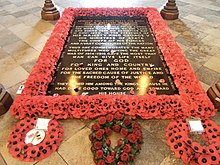Wikipedia:WikiProject Military history/News/November 2020/Op-ed
|
Leaning on the Everlasting Arms |
- By TomStar81
In November 1920, two years following the end of World War I, the British and French acted to symbolically inaugurate national monuments to those who fell in battle during the war. These monuments, whose name would be taken from an inscription on the grave of a deceased British soldier that Reverend David Railton had seen which bore the pencil-written legend "An Unknown British Soldier", has since become an important and in many ways iconic reminder of those who gave their lives for their countries in war.
The concept for this monument was simple, a soldier from the field whose identity was unknown (or "known only to God", or wording to that effect) would be selected and ferried to a national memorial where he would be interred and watched over by his fellow countrymen as a visual reference to those who died in battle. In this sense then, the unknown soldier would share a trait with the Titan Atlas, who held the weight of the heavens upon his shoulders after the war between the Titans and the Gods: he would symbolically hold the weight of all those lost or killed on his shoulders in 1914-1918.
David Railton suggested (together with the French in their country) the creation at a national level of a symbolic funeral and burial of an "Unknown Warrior", proposing that the grave should in the UK include a national monument in the form of what is usually, but not in this particular case, a headstone. The idea received the support of the Dean of Westminster, Prime Minister David Lloyd George, and later from King George V, responding to a wave of public support. At the same time, a similar concern grew in France. In November 1916, a local officer of Le Souvenir français proposed the idea of burying "an unknown soldier" in the Panthéon. A formal bill was presented in Parliament in November 1918. The decision was voted into law on September 1919. The formal inauguration of the memorials with services for the dead occurred on Armistice Day, while the actual burial of the body was said to have occurred later.
Once the monuments were inaugurated, the idea caught fire and spread to other nations. In the United States, Italy and Portugal, Tombs for the Unknown Soldiers were formally established in 1921, while other nations like Russia and Argentina would follow later. In many cases these tombs are staffed by members of an armed military honor guard, who serve as watchful protectors for the interred, while those interred are frequently recipients of their nation's highest award(s) and in some cases recipients of high awards or honors by allied or other friendly nations in an attempt to show solidarity for the struggles of the wars fought together.

When the first soldiers were selected and symbolically buried it was for its time expressly understood that their identities would be unknown not for lack of want but for lack of ways to positively identify the dead. While this has been largely true for the World Wars, Korea and Vietnam, the introduction of forensic sciences coupled with the use of DNA testing has matured enough that those who actively research the greater fields of MIA/POW/KIA military personnel are beginning to show some progress at identify previously unknown remains. To date, while the science has proven sound, only one unknown soldier of the numerous buried has been identified in a definitive capacity. In 1994, Ted Sampley, a POW/MIA activist, determined that the remains of the Vietnam Unknown interred in the United States were likely those of Air Force 1st Lt. Michael Joseph Blassie, who was shot down near An Lộc, Vietnam, in 1972. Sampley published an article in his newsletter and contacted Blassie's family, who attempted to pursue the case with the Air Force's casualty office without result.
In January 1998, CBS News broadcast a report based on Sampley's investigation which brought political pressure to support the identification of the remains. The body was exhumed on May 14, 1998. Based on mitochondrial DNA testing, Department of Defense scientists confirmed the remains were those of Blassie. The identification was announced on June 30, 1998, and on July 10, Blassie's remains arrived home to his family in St. Louis, Missouri; he was re-interred at Jefferson Barracks National Cemetery on July 11. The identification took place after Blassie's family lobbied the Pentagon to perform the DNA testing. His remains (6 partial bones) had originally been recovered several months after his aircraft had been shot down and were not sufficient to allow for positive identification at the time. Since his exhumation the panel formally recognizing him as the Vietnam War Unknown has been replaced by a generic panel intended to honor those who died in service to the United States.
|




